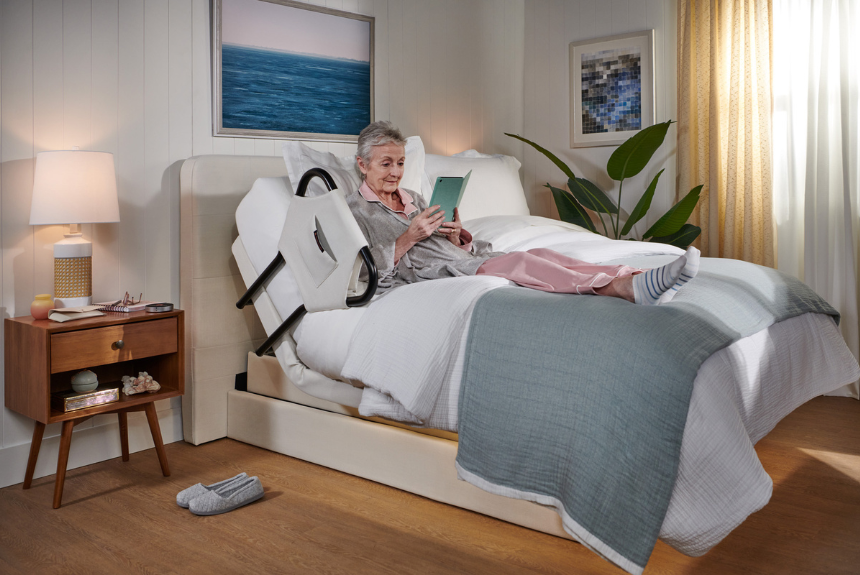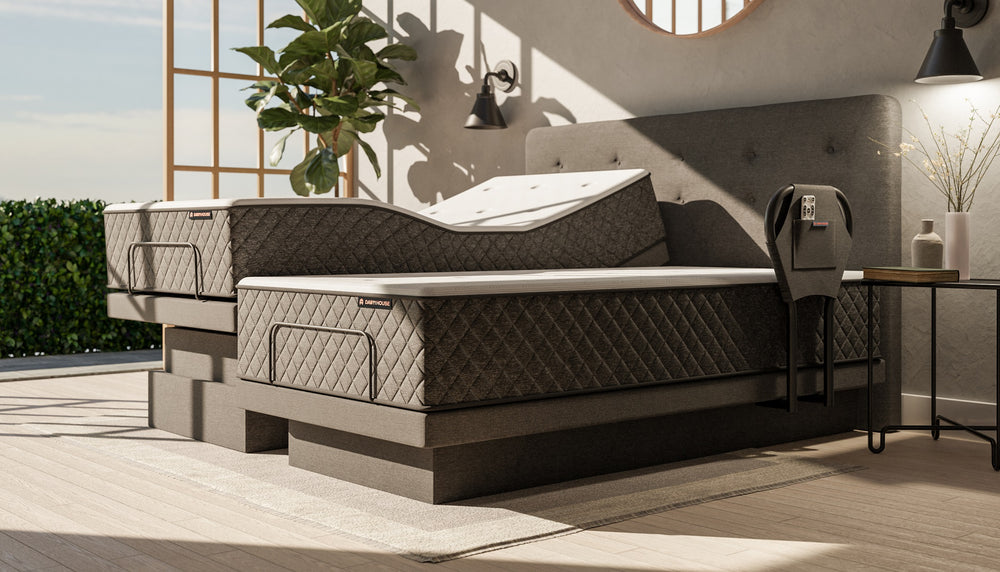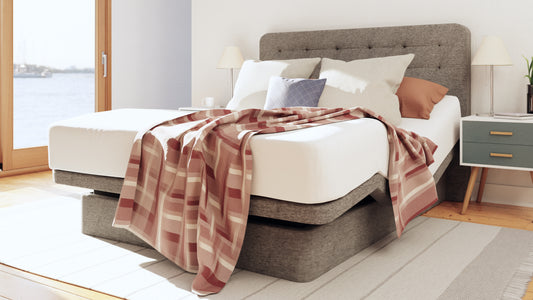Knowing how to adjust the height and other features of a hospital bed can make caregiving more manageable and provide a better experience. In this guide, you’ll learn exactly how to lower a hospital bed, why height adjustments are essential, and whether there’s a better alternative for homecare needs.
How to Adjust the Height of Hospital Beds
Adjustable hospital beds come with either manual or electric mechanisms to modify their height. Knowing how to use these systems properly is crucial for ensuring safety and comfort.
Electric Hospital Beds
Most modern hospital beds are electric, meaning you can adjust the height at the push of a button. These beds typically come with a remote control or a panel on the side. To lower the bed:
-
Locate the remote control or control panel. Most remotes are labeled with clear buttons for raising and lowering the bed.
-
Press the "lower" button. Hold the button until the bed reaches the desired height.
-
Adjust slowly. Make small adjustments to ensure the user’s feet can touch the ground if they are sitting up, but also check that the bed isn’t too low for caregivers to work comfortably.
Manual Hospital Bed Lowering Mechanisms
Manual hospital beds use cranks instead of electronics. While they’re less convenient, they’re just as effective when used correctly. To lower the height of a manual bed:
-
Locate the crank. It’s usually found at the foot of the bed.
-
Turn the crank counterclockwise. This action lowers the bed gradually.
-
Test the height. Check the height after each adjustment to ensure it’s suitable for both the user and the caregiver.
Keep in mind that manual mechanisms require physical effort and may not be ideal for those with mobility issues or limited strength.
Hi-Low Hospital Beds
Hi-low hospital beds are specifically designed for height versatility. These beds allow for a greater range of height adjustments, from very low to accommodate getting in and out safely, to higher positions for medical procedures or caregiving. Most hi-low beds are electric, making them easy to use in homecare situations.
What’s the Ideal Height for a Hospital Bed?
For Getting In and Out of Bed
The bed should be low enough for the user’s feet to rest flat on the floor when sitting on the edge. This reduces the risk of falls and makes transitioning easier. A typical ideal height is around 16 to 23 inches from the floor to the top of the mattress.
For Caregiving Activities
If a caregiver needs to assist with repositioning, wound care, or other tasks, the bed should be raised to a height that minimizes strain on their back. For most people, this is around 28 to 34 inches.
For Sleeping
When the user is lying down, the bed height should allow them to feel secure without feeling like they’re too high off the ground. A height of 20 inches is a common middle ground.
Consider:
-
Patient’sMobility: Lower beds are better for those who are at risk of falling, while higher beds may work for patients with better mobility.
-
Caregiver Needs: A height that’s ergonomic for caregiving tasks is vital to prevent injuries.
-
Mattress Thickness: Don’t forget to factor in the mattress when calculating the bed’s height.
Average Dimensions of Hospital Beds
Length and Width
-
Standard hospital beds: Usually 80 inches long and 36 inches wide.
-
Bariatric beds: Designed for larger users, they can measure up to 88 inches long and 48 inches wide.
Height Range
-
Electric hospital beds: Adjustable from 16 to 30 inches in most models.
-
Hi-low hospital beds: Offer a wider range, often from 7 inches (ultra-low) to 36 inches.
How to Lower the Rails in Hospital Beds
While adjusting the height is essential, lowering the rails also plays a significant role in safe and easy access. Most hospital beds have side rails that can be raised or lowered depending on the user’s needs.
Steps to Lower the Rails
-
Locate the release mechanism. Most hospital bed rails have a lever or button near the base.
-
Press and hold the lever or button. This unlocks the rail, allowing you to lower it.
-
Lower the rail slowly. Ensure it locks into place once lowered to avoid accidents.
When to Lower the Rails
-
When the user is getting in or out of bed.
-
During caregiving tasks, such as bathing or repositioning.
-
If the user finds the rails restrictive or uncomfortable.
Lowering the rails provides better access, but also ensures they are raised when needed to prevent falls, especially during the night.
Get a More Comfortable Alternative to Hospital Beds
While hospital beds are essential for those with medical needs, they’re often associated with a clinical appearance and limited comfort. If you’re using a hospital bed at home, you might find it doesn’t quite match the coziness or aesthetics you’d prefer. That’s where homecare adjustable beds come in. These beds offer the best of both worlds: the medical functionality you need and the comfort and style you want for your living space.
Why Choose a Homecare Adjustable Bed?
Homecare adjustable beds are a modern alternative to hospital beds, providing all the necessary features for medical care while blending seamlessly into your home. Whether you need height adjustments, head and foot elevation, or other customizable options, these beds are designed with both the user and their caregivers in mind.
Unlike hospital beds, which prioritize function over form, homecare adjustable beds look and feel more like traditional beds. They come in various styles, materials, and mattress options, giving you more control over the appearance and comfort level.
Expanded Benefits of Homecare Adjustable Beds
1. Improved Comfort
Homecare adjustable beds prioritize comfort without compromising functionality. The mattresses are often designed with materials like memory foam or hybrid layers to ensure proper support while providing a plush, luxurious feel. Unlike hospital beds that may feel stiff or rigid, these beds are crafted for restful sleep and prolonged use.
2. Seamless Adjustments
Most homecare adjustable beds come with easy-to-use electric controls, allowing you to raise or lower the bed, head, or foot with just the press of a button. This feature makes it simple for users to find the perfect position for sleeping, sitting, or relaxing. It’s also helpful for caregivers, who can adjust the bed height to a comfortable level for caregiving tasks like bathing or repositioning.
3. Enhanced Safety Features
Safety remains a top priority with homecare adjustable beds. These beds often include features like side rails, anti-slip surfaces, and height adjustment ranges similar to those found in hospital beds. This ensures the user’s safety during sleep and transfers while reducing the clinical look that hospital beds often have.
4. Aesthetic Appeal
One of the most significant advantages of homecare adjustable beds is their design. They come in a variety of finishes, headboards, and frames that can complement any home decor. This makes them a great choice for those who want their bedroom to feel like a relaxing retreat rather than a medical space.
5. Ergonomic Design for Caregivers
Homecare adjustable beds aren’t just for the user—they’re also designed with caregivers in mind. The ability to raise the bed to a comfortable working height can significantly reduce the physical strain on caregivers. This ergonomic feature helps prevent back injuries and ensures caregiving tasks are easier to perform.
6. Versatility for Long-Term Use
Unlike traditional hospital beds that are often temporary, homecare adjustable beds are a long-term investment. They’re built to last and can serve various purposes over time, whether you’re recovering from surgery, managing a chronic condition, or simply seeking added comfort in your daily life.
Dawn House: The Gold Standard in Homecare Adjustable Beds
If you’re looking for the best homecare adjustable bed, consider the options from Dawn House. Their beds are thoughtfully designed to cater to medical needs while maintaining the coziness of a traditional bed. Here’s why Dawn House beds stand out:
-
Advanced Features: They include smart controls, adjustable height ranges, and customizable positioning for optimal support.
-
Premium Comfort: Designed with high-quality mattresses that support your body and improve sleep quality.
-
Stylish Design: Dawn House beds blend beautifully into your home with elegant finishes and modern aesthetics.
-
Health Monitoring Options: Some models offer advanced features like sleep tracking and built-in health monitoring, adding even more value.
Ready to Upgrade?
If you’re ready to move on from the clinical feel of a hospital bed, a homecare adjustable bed is the perfect alternative. Not only will it improve your comfort and safety, but it will also enhance your home environment. To learn more, check out our guide to making a hospital bed more comfortable. Dawn House beds are a game-changer for anyone who needs a functional yet inviting solution for homecare needs.
With a homecare adjustable bed, you’re not just investing in a piece of furniture—you’re investing in better rest, greater comfort, and a higher quality of life.
Final Thoughts
Adjusting the height of a hospital bed is simple once you understand how the mechanisms work, whether it’s an electric bed or a manual model. Getting the right height isn’t just about comfort—it’s about safety and ease for both the user and caregivers.
If hospital beds feel too clinical for your home, consider upgrading to a homecare adjustable bed. It provides all the features of a hospital bed with added comfort and style to fit seamlessly into your home.



